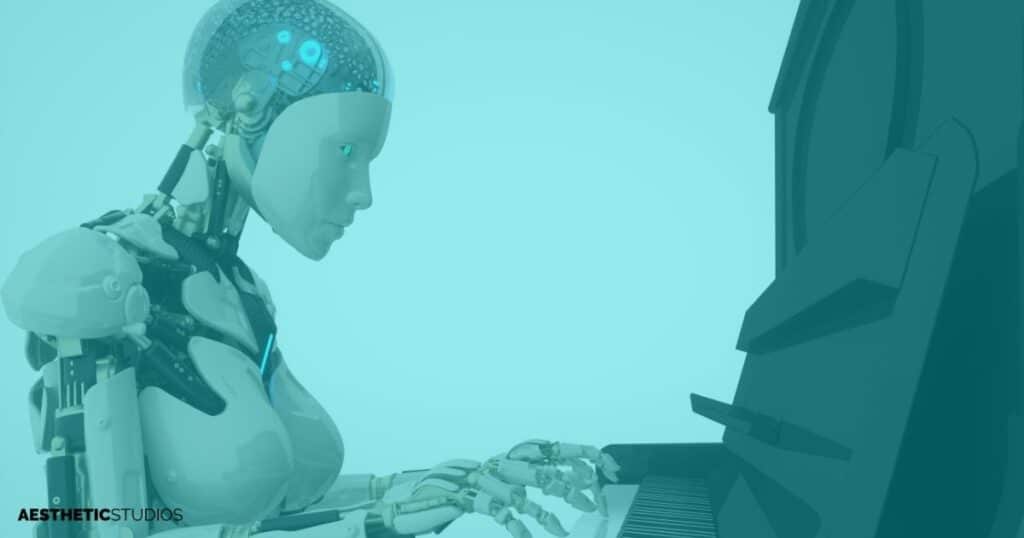Will Web Design Be Replaced By AI?

Are you worried that AI might replace your job as a web designer? Maybe you’ve heard about the impressive advancements in AI technology and felt anxious about your future. Or you’re just curious about what AI can do for web design and whether it can match human creativity. I’m here to tell you you’re not alone in these thoughts. As someone deeply involved in both web design and AI, I understand the mix of fear and excitement surrounding this topic. The truth is, that AI is indeed making waves in the industry, but does that mean it will completely take over? In this article, you’ll learn about the current capabilities of AI in web design, its limitations, and how you can leverage this technology to enhance your skills and stay relevant. By the end of this article, you’ll have a clear understanding of AI’s role in web design and practical tips on how to adapt and thrive in an AI-driven world. Let’s dive in and explore the future of web design together. Current State of AI in Web Design AI has come a long way in recent years, making significant strides in various fields, including web design. Today, AI tools can assist with numerous tasks, from automating routine processes to generating design elements. But what exactly can AI do in web design right now? AI Tools and Their Capabilities Website Builders Platforms like Wix and Squarespace have integrated AI to help users create websites quickly and efficiently. For example, Wix’s ADI (Artificial Design Intelligence) can build a custom website based on user inputs and preferences within minutes. It takes care of layout, colour schemes, and even some content. Design Assistance Tools like Adobe Sensei and Sketch’s AI-powered features help designers by automating repetitive tasks. Adobe Sensei can suggest design elements, optimise images, and even predict user behaviour to enhance the design process. Sketch uses machine learning to automate resizing and alignment tasks, saving designers valuable time. Content Generation AI can assist in generating content for websites. Tools like Writesonic and Copy.ai use natural language processing to create text that fits seamlessly with the website’s design and tone. This is particularly useful for generating product descriptions, blog posts, and other textual elements. User Experience (UX) Optimisation AI-driven analytics tools such as Hotjar and Crazy Egg can track user behaviour and provide insights on how to improve website design for better user engagement. These tools analyse data to suggest changes that can enhance the user experience, such as adjusting the placement of buttons or modifying navigation flows. Examples of AI in Action The Grid One of the pioneering AI-powered web design platforms, The Grid uses an AI named Molly to design websites. Molly analyses user content and makes design decisions, aiming to create aesthetically pleasing and functional websites without human intervention. Firedrop Another example is Firedrop, which uses an AI named Sacha. Sacha interacts with users through a chatbot interface, asking questions about their design preferences and then creating a website based on their responses. While these tools and examples showcase AI’s potential, it’s essential to recognise that AI in web design is still evolving. The current state of AI offers significant assistance but has limitations that prevent it from fully replacing human designers. Can AI Replace Human Creativity? One of the most significant concerns among web designers is whether AI can truly replicate human creativity. While AI tools have shown remarkable capabilities in automating tasks and generating content, there are inherent limitations that prevent them from fully replacing human designers. Let’s explore these limitations and understand why human creativity remains indispensable. Limitations of AI in Replicating Human Creativity Lack of Emotional Understanding AI cannot comprehend and interpret emotions. Human designers can create websites that evoke specific feelings, resonate with the target audience, and convey brand identity. AI, on the other hand, can only follow predefined rules and patterns, making it challenging to infuse genuine emotional depth into designs. Originality and Innovation Human creativity thrives on originality and the ability to think outside the box. While AI can generate designs based on existing data, it often struggles to produce truly innovative and unique concepts. Originality comes from human experiences, cultural nuances, and personal insights—elements that AI cannot fully replicate. Understanding Context and Nuance Context and nuance play a crucial role in effective web design. Human designers understand the subtleties of user behaviour, cultural differences, and industry-specific trends. AI can analyse data and provide recommendations, but it often misses the finer details that make a design truly effective and tailored to the audience. Iterative Creative Process The creative process involves brainstorming, experimentation, and iteration. Human designers can refine and adapt their work based on feedback and evolving ideas. AI lacks the intuition and flexibility to navigate this iterative process, often producing designs that lack the polish and refinement achievable through human creativity. The Human Touch in Web Design Despite the impressive capabilities of AI, the human touch remains irreplaceable in web design. Here are a few reasons why: Empathy and User-Centric Design Human designers excel at empathising with users and understanding their needs and pain points. This empathy leads to user-centric designs that provide a seamless and engaging experience. AI, while helpful in providing data-driven insights, cannot fully grasp the complexities of human emotions and behaviours. Storytelling and Brand Identity Effective web design is about more than just aesthetics; it’s about telling a story and creating a strong brand identity. Human designers bring a narrative element to their work, crafting designs that communicate a brand’s values and message. AI-generated designs may lack this cohesive storytelling ability, resulting in generic and impersonal websites. Collaboration and Communication The collaborative nature of web design involves communication between designers, clients, and other stakeholders. Human designers can interpret feedback, engage in meaningful discussions, and adjust their work accordingly. This level of interaction and adaptability is something AI cannot replicate, as it operates within the confines of its programming. While AI can certainly enhance and streamline the web
Will Web Design Be Automated?

Have you ever wondered if web design could be fully automated? This question is more pertinent than ever with rapid advancements in AI and automation technologies. As a web designer, developer, business owner, or tech enthusiast, you might feel a mix of curiosity and concern. Will these new tools enhance your workflow or make your job obsolete? As someone deeply entrenched in both web design and the latest tech trends, I understand the anxieties and opportunities that come with automation. In this article, you will discover how automation transforms web design, the benefits and limitations of these changes, and, most importantly, how you can stay relevant and thrive in this evolving landscape. By the end of this article, you will have a clear understanding of the future of web design and actionable strategies to adapt and succeed. Let’s delve into the world of automated web design and uncover what lies ahead. The Current State of Web Design Web design today is a blend of creativity, technical skill, and an understanding of user experience. Traditional web design processes typically involve multiple stages: Planning and Research Wireframing and Prototyping Design and Development Testing and Launch Each stage requires collaboration between designers, developers, and clients, ensuring the final product is both aesthetically pleasing and functional. Despite the meticulous effort, traditional web design can be time-consuming and costly. However, the landscape is changing with the advent of automation tools. These tools aim to streamline parts of the design and development process, making it more efficient and accessible. Platforms like Wix, Squarespace, and WordPress have introduced automated features that simplify website creation, allowing users with little to no coding knowledge to build professional websites. Additionally, AI-driven tools like The Grid and Bookmark are pushing the boundaries by offering more personalised design suggestions and automated layouts based on user inputs.As automation continues to evolve, it is essential to understand its current capabilities and limitations, setting the stage for the transformative impact it might have on web design in the future. The Rise of Automation in Web Design Automation in web design isn’t a futuristic concept—it’s already here, and it’s rapidly gaining momentum. The integration of AI and machine learning into web design is revolutionising how websites are created, maintained, and optimised. Here’s a closer look at how these technologies are reshaping the industry: AI-Powered Design Tools Automated Coding and Development Content Management Systems (CMS) with Automation Features AI in User Experience (UX) and Personalisation As these technologies become more sophisticated, they offer significant advantages in terms of efficiency, cost-effectiveness, and accessibility. However, it’s essential to recognise that while automation tools can handle many aspects of web design, they are not a complete replacement for human creativity and intuition. Instead, they serve as valuable aids that can enhance the capabilities of web designers, allowing them to focus on more complex and creative tasks. Benefits of Automated Web Design Automation in web design offers several compelling advantages that can transform how websites are built and maintained. Here are some key benefits that automated tools bring to the table: Efficiency and Time-Saving Cost Reduction Enhanced Accessibility for Non-Designers Consistency and Quality Data-Driven Insights and Personalisation Scalability While these benefits highlight the transformative potential of automation in web design, it’s important to balance them against the challenges and limitations that come with these technologies. Challenges and Limitations While automation in web design offers numerous benefits, it’s not without its challenges and limitations. Understanding these can help you better navigate the evolving landscape and make informed decisions about integrating automation into your workflow. Creativity and Customisation Concerns Job Displacement Fears Technical Limitations and Dependency Quality Control Issues Security and Privacy Concerns Adaptation and Learning Curve Despite these challenges, the potential for automation to enhance and transform web design is significant. By understanding the limitations and proactively addressing them, designers and developers can leverage these tools to their advantage. Future Outlook As we look to the future, it’s clear that automation will continue to play a significant role in the evolution of web design. The next decade promises exciting advancements and new opportunities for designers and developers. Here’s what you can expect: Increased Integration of AI and Machine Learning Enhanced Collaboration Between Humans and AI New Roles and Opportunities Continuous Learning and Adaptation Ethical and Inclusive Design Evolving User Expectations Staying Relevant in an Automated World As automation continues to shape the landscape of web design, staying relevant requires proactive adaptation and a commitment to continuous learning. Here are some strategies to help you thrive in an increasingly automated industry: Focus on User Experience (UX) Embrace Continuous Learning Develop Technical Proficiency Enhance Your Creativity Leverage Data-Driven Design Cultivate Soft Skills Explore New Roles and Opportunities Network and Engage with the Community By focusing on these strategies, you can remain competitive and relevant in an increasingly automated world. Embracing change and continuously improving your skills will ensure you not only survive but thrive in the evolving landscape of web design. Moving Forward, As we reflect on the journey of web design from its traditional, manually-intensive processes to the increasingly automated workflows of today, it’s evident that the integration of artificial intelligence and machine learning is not just a trend, but a transformative force reshaping the industry. While the thought of automated design tools may stir concerns about job security and the devaluation of human creativity, it’s crucial to recognize the unique opportunities these technologies offer. They not only streamline mundane tasks and reduce operational costs but also open up avenues for web designers to delve deeper into innovative and strategic aspects of design. By leveraging AI to handle the repetitive elements of the process, designers are freed to focus on crafting more engaging, nuanced, and user-centric experiences, ultimately enhancing the value they bring to the digital landscape. Looking ahead, the future of web design promises an exciting blend of human ingenuity and technological advancement. To stay relevant and excel in this evolving environment, web professionals must adopt a mindset of continuous learning
Custom Websites vs Templates: A Comprehensive Comparison

Do you need help deciding between custom-built and template websites for your business? You’re not alone. This is a common dilemma for many business owners who want a professional online presence without breaking the bank. We understand the confusion and anxiety you might be feeling. With years of experience in web development and digital marketing, we’ve seen firsthand the benefits and drawbacks of both approaches. This article aims to provide you with a clear, unbiased cost-benefit analysis, helping you make an informed decision that best suits your business needs and budget. By the end of this article, you’ll have a comprehensive understanding of both custom web development and template websites. You’ll know the costs involved, the benefits and drawbacks, and the factors to consider in making your decision. Let’s dive in and explore which option will give you the best return on investment. Understanding Custom Web Development Definition and Overview Custom web development involves creating a website from scratch, tailored specifically to your business’s unique needs and goals. Unlike template websites, which use pre-designed themes, custom websites are built to your specifications, offering unparalleled flexibility and customisation. This process typically involves working closely with a web developer or a development team to design and develop every aspect of the site, from layout and design to functionality and features. Costs Involved Custom web development is generally more expensive than using a template. Here are some of the key costs to consider: Initial Development Hiring a professional developer or development team can be costly. Prices vary depending on the complexity of the project, but you can expect to pay anywhere from a few thousand to tens of thousands of dollars. Design Fees Custom designs require the skills of a professional designer, adding to the overall cost. Maintenance and Updates Ongoing costs include regular maintenance, updates, and potential redesigns to keep the site current and functional. Hosting and Domain Custom websites often require more robust hosting solutions, which can be more expensive than basic hosting plans used for template sites. Benefits and Drawbacks Benefits: Drawbacks: Suitable Use Cases Custom web development is ideal for businesses with specific needs that cannot be met by a template. This includes: E-commerce Sites Businesses that require complex e-commerce functionalities and custom integrations. Brands Seeking Unique Design Companies that want a distinctive online presence that reflects their brand identity. Large Enterprises Organisations with extensive content and functionality requirements need a scalable solution. Specialised Services Businesses offering unique services that require customised user interfaces and experiences. By understanding the ins and outs of custom web development, you can better assess whether it’s the right choice for your business. Understanding Template Websites Definition and Overview Template websites are pre-designed website frameworks that allow you to quickly set up and customise a site using a visual editor. These templates are often available through website builders like WordPress, Wix, or Squarespace. They come with a variety of themes and layouts, which can be tailored to match your branding to some extent, making them a popular choice for businesses looking for a quick and cost-effective web solution. Cost Comparison When deciding between custom web development and template websites, understanding the financial implications is crucial. Here’s a detailed comparison of the costs involved, using AUD for all values. Initial Setup Costs Custom Web Development: Template Websites: Maintenance and Updates Custom Web Development: Template Websites: Long-Term Investment Considerations Custom Web Development: Template Websites: By comparing the costs involved in custom web development and template websites, you can better understand which option fits your budget and long-term business goals. Benefit Analysis To make an informed decision between custom web development and template websites, it’s essential to understand the benefits each option offers. Here, we’ll explore flexibility, SEO and performance, user experience, and design. Flexibility and Customisation Custom Web Development: Template Websites: SEO and Performance Custom Web Development: Template Websites: User Experience and Design Custom Web Development: Template Websites: Making the Decision Deciding between custom web development and template websites depends on several factors unique to your business. Here, we’ll guide you through the critical considerations to help you make an informed choice. Factors to Consider Budget Timeframe Complexity and Specific Needs Scalability Custom Web Development: Highly scalable and adaptable. Best for businesses planning significant growth and requiring a website that can evolve with them. Template Websites: Limited scalability. Suitable for businesses that do not anticipate extensive growth or complex needs soon. Brand Identity Questions to Ask Yourself Final Recommendations For Startups and Small Businesses If you’re just starting and need a professional online presence quickly and affordably, a template website is a great choice. It allows you to get online fast without a hefty investment. For Established Businesses and Enterprises If you have the budget and require a website that can scale with your business, invest in custom web development. It offers the flexibility and bespoke features that will serve you well in the long run. For Businesses in Transition If you currently use a template website but find it limiting as you grow, consider transitioning to a custom website. The initial investment will be justified by the enhanced functionalities and better user experience. By weighing these factors and asking the right questions, you can make a well-informed decision that aligns with your business goals and budget. Moving Forward, Choosing between custom web development and template websites is a significant decision that impacts your business’s online presence and growth. Here’s a quick recap of what we’ve covered: Custom Web Development: Offers bespoke design, tailored functionalities, and scalability, but comes with higher costs and longer development times. Template Websites: Provide a cost-effective, quick-to-launch solution with professional designs, but may lack uniqueness and advanced customisation. Ultimately, the best choice depends on your specific needs, budget, and long-term goals. Take the time to evaluate your options, consider the factors discussed, and make a decision that will best serve your business now and in the future. Remember, your website is a crucial tool for connecting with your audience and



